Abstract
This paper extends previous work on echo chambers modeled by an Ising-like system at zero temperature (Spontaneous Symmetry Breaking, Group Decision Making and Beyond 1: Echo Chambers and random Polarization, Symmetry 2024, 16(12), 1566). There, polarization emerged as a spontaneous symmetry-breaking process with a randomly selected direction. Here using a mean-field analysis and Monte Carlo simulations I show that this mechanism is highly vulnerable to minimal distortions. An external symmetry-breaking field, even very small, suffices to impose a global direction and suppress opposite domains, producing distorted full polarization. In contrast, a handful of quenched local fields with zero average do not erase polarization but reorganize it into opposing domains. Remarkably, as few as two opposed fields, if placed at tipping sites, can redirect the entire system. These fragile sites, indistinguishable from others, act as hidden tipping points that amplify microscopic biases into macroscopic outcomes. The difference in local field proportions is found to be instrumental to guaranteeing a winning majority. The results highlight how minimal, strategically placed interventions can override autonomous self-organization. The results could, if applicable to social media platforms, question their presumed democratic nature of consensus.
1. Introduction
In condensed matter systems, long-range order can arise either spontaneously, emerging from microscopic fluctuations without directional bias, or as a state imposed by external or internal fields. Spontaneous long-range order reflects the intrinsic capacity of a system to break symmetry under stochastic initial conditions, whereas pre-defined long-range order results from constraints that bias the dynamics toward specific ordered configurations. The distinction between these two regimes, intrinsic versus imposed, highlights both the generative power and the fragility of symmetry breaking [1,2,3,4].
Beyond physical systems, such mechanisms resonate with broader classes of emergent behavior under constraint [5]. Indeed, in a previous paper entitled “Spontaneous Symmetry Breaking, Group Decision Making and Beyond 1: Echo Chambers and random Polarization” [6], I built a model of opinion dynamics using an Ising-like system at zero temperature. There, polarization is the substitute for long-range order and similarly emerges as a spontaneous symmetry-breaking process with a randomly selected direction for the final unanimous collective choice. Here, as in the first paper, I define an echo chamber as a network of agents who are all sharing the same view about a given issue with no agent holding an opposite view.
However, I have emphasized major differences with physical systems, claiming that with regard to social systems, the history, the initial conditions as well the actual scheme used for the updating do matter and are instrumental, relevant features in the final stable outcome. As one of the model outcomes, echo chambers were found to emerge as the outcome of a dynamical opinion update process rather than from preferential attachment as usually assumed [7].
Here I show that the random selection of the final outcome is fragile and can be easily distorted. The application of a very small external symmetry-breaking pressure at the early stage of the process suffices to impose the collective ordering and erase the formation of opposite domains. Polarization is thus easily distorted by even minimal external pressures on the community.
In contrast, I find that a few quenched local fields lead to qualitatively different outcomes. Instead of suppressing domains with one unique polarization, they stabilize the coexistence of domains with opposite orientations. Strikingly, as few as two opposed fields are sufficient to redirect the entire system, provided they are located at specific tipping sites.
Monte Carlo simulations [8,9,10] uncover these tipping sites as hidden weak points. They are indistinguishable from others yet capable of steering the global evolution when activated. Mean-field analysis confirms these tendencies but misses a variety of outcomes uncovered by Monte Carlo simulations, whose outcomes depend on the microscopic details of the initial conditions.
Altogether, the results demonstrate how both external fields and localized quenched biases provide low-cost paths to distort polarization. They also reveal the disproportionate impact of some tipping sites, and more broadly, the vulnerability of symmetry-breaking processes to minimal but strategically positioned interventions.
While these findings have been obtained with a two-dimensional Ising-like model using grids of various sizes with , , , , they could have direct implications for opinion dynamics in social platforms, where structural fragilities may silently convert weak local biases into distorted macroscopic consensus. Indeed, if applicable to social media platforms, those findings question their presumed democratic nature.
This work relies on earlier work about group decision making [11,12,13] and subscribes to the new [14,15] and very active field of sociophysics [16,17,18,19,20,21,22,23,24,25,26,27,28,29,30,31,32,33,34,35,36,37,38,39,40,41,42,43,44,45,46,47,48,49,50,51,52,53,54,55,56,57,58,59,60,61]. The Ising-like model has inspired many related papers [62,63,64,65,66,67,68].
The rest of the paper is organized as follows: Section 2 reviews the model of opinion dynamics used in the first paper of this series [6]. I apply small external pressure in Section 3. A homogeneous external pressure is studied in Section 3.1, while diluted heterogeneous individual pressures are considered in Section 3.2. Sub-cases with one single pressure and two opposite individual pressures are included. Having both external uniform pressure and individual pressures is investigated in Section 3.3. A series of Monte Carlo simulations were performed as detailed in Section 4. Three sub-cases are analyzed with symmetric initial configuration and local fields, asymmetric initial configuration and local fields and a single local field. Section 5 contains the conclusion where the results are discussed.
2. Model Used in the First Paper
In the first paper of this series [6], I considered a collection of N symmetrical equiprobable discrete bimodal individual choices ( with ) who interact by pairs. Given a configuration of individual choices , I defined the magnitude of the group utility function as
where I have assumed a constant amplitude J for all pairs of connected agents. The term represents all interacting pairs in the group. Each agent does not interact with all the others.
The associated quantity
measures the amplitude of the actual social impact of the group aggregate choices with . In parallel,
measures the related degree of the symmetry breaking with .
In addition I have introduced and to count the respective numbers of agents having chosen and . Actual social and cultural impacts are then proportional to and . Proportions and with measure the degree of diversity of the N-person group.
Invoking the effect of individual anticipation, I performed a mean-field treatment of Equation (1) to get the anticipated group utility function,
where
defines the group pressure on each person for an aggregated choice C. The parameter is a constant independent of the group choice and thus does not affect the expected collective choice C. Since the parameter k is the number of persons individual i interacts with by pairs, is a measure of the strength of interactions of a given site with its k neighbors rescaled by the total number (N-1) of sites in the group and is identical for all the group members. The superscript a signals that the anticipating process has been applied.
Assuming that each person seeks to optimize their utility, Equation (4) indicates that favors individual choices, while favors individual choices. Rewriting turns Equation (4) to
where is the utility function of the full group given a collective choice C, which is unknown at this stage. The actual value of C is the one maximizing yielding .
The anticipation process is thus found to produce a symmetry breaking along either +1 or −1. It is of importance to emphasize that both possibilities are equiprobable. While all pair interactions lead to an identical choice polarization upon optimization of individual utilities, the choice itself is randomly selected. That is a major result, which demonstrates that the symmetry breaking is spontaneous and random with no a priori.
This unexpected result has been confirmed by Monte Carlo simulations except for the emergence of domains of opposite polarizations, which are found in the simulations but are absent from the mean-field treatment yielding . The domain formation obtained from Monte Carlo simulations was shown to be a function of the history of the system, its size and the algorithm used for individual updates [6].
3. Applying Small External Pressures
While the direction of the spontaneous symmetry breaking is random for a pair interacting with a homogeneous population, applying a small external symmetry-breaking uniform pressure may in some case impose the choice along which the spontaneous polarization is achieved.
3.1. Applying a Small External Pressure Prior to the Interacting Dynamics
When the external pressure is applied prior to the launching of the update dynamics, the utility function writes
where P is the external pressure.
Activating the anticipation effect, Equation (7) becomes
leading to
which is no longer maximum for due to the term . Now , making for maximum and when , independently of the actual magnitude of P. Even an infinitesimal external pressure is sufficient to select the final collective state.
3.2. Applying Diluted Heterogeneous Individual Pressures
Applying an infinitesimal external pressure was shown to have a substantial impact on the process of spontaneous symmetry breaking driven by pair interactions by selecting the choice along which the group ends up fully polarized, the underlying condition being that the same infinitesimal external pressure must be applied to each member of the group. Although the cost of activating an infinitesimal external pressure may be low, the application to all group members can be quite demanding. On this basis, I now investigate the impact of having a highly diluted external pressure.
3.2.1. A Single Individual Pressure
Applying a single individual pressure to agent m yields
and
Equation (11) shows that an infinitesimal single individual pressure is sufficient to distort the spontaneous symmetry breaking along a pre-selected choice. It is a low-cost lever to impose the choice of the group. However, I must stress that this observation arises from the mean-field treatment, which has de facto waived out all fluctuations. The utility gain is then with a cost when the alignment of the group is not along the single individual pressure. It is a relatively small value with respect to . I thus expect the Monte Carlo simulation to temper this low-cost alignment with the formation of domain barriers hindering a unique full polarization (see Section 4).
3.2.2. Two Opposite Individual Pressures
Adding a second opposite individual pressure with to agent n yields
and
with .
Maximizing Equation (13) always yields with the values of to be evaluated. Four configurations are then available, with
- ,
- ,
- ,
- ,
which can be recast as
- ,
- ,
- ,
- ,
where the constant has been dropped from the four quantities , which still have to be compared to identify the various maximums as a function of the magnitude of the two individual pressures.
Comparing the Above Four Cases
The last case can be dropped at once with all three terms of being negative.
To compare the three other cases, I start with the condition , which eliminates case 2 with . Then, must be compared to . To reach requires the condition , which is equivalent to leading to . In contrast, makes case 3 the maximum.
Considering eliminates case 1 with , leaving cases 2 and 3 to be compared, to have requires the condition , which is equivalent to leading to . In contrast, makes case 3 the maximum.
Three Successive Steps
To sum up, the maximization process proceeds in three successive steps. First, the symmetry-breaking amplitude C is set equal to with to be determined. Then the larger individual pressure is satisfied, i.e., if or if . That leads to or , respectively.
Finally, the second smaller individual pressure () is satisfied provided () leading to (). Otherwise, when (), ().
When the four utilities become , and . Therefore when yielding , . For , yielding . The random breaking of the symmetry is thus recovered.
From One Individual Pressure to Many
Accordingly, while one single individual pressure allows selection of the symmetry breaking at a low cost, adding a second opposite one makes the strategy more uncertain. Indeed, to select the symmetry breaking requires an individual pressure larger than the other one, which in turn can lead to a headlong rush.
Adding more individual fields will extend the above three-step process to a larger hierarchical step process. In addition, grouping similar local pressures may trigger the formation of domains. This feature is studied in the next Section using Monte Carlo simulations.
3.3. The Full Pressure Case
Having both external uniform pressure and individual pressures lead to the complete utility function,
which is identical to the statistical physics Hamiltonian of a Random Field Ising Model [69] and where each is either positive or negative with being positive, negative or null.
Applying local individual pressures is thus a way to oppose an external uniform pressure provided .
At this stage it is also worth stressing that while both uniform and individual external pressures are produced by some extra-individual body, internal pressures could have an additional origin. Indeed, the individual pressures can stem from the individuals who are being subjected to them. In another model I have developed for opinion dynamics, I defined a person i subjected to a local field as inflexible [70] or stubborn [71]. In both cases, the effect is identical given this person does not shift opinion and always keeps the choice aligned with the local field in the present case.
4. Monte Carlo Simulations to Investigate the Formation of Domains
In the first paper of this series [6], I have shown how the history of a given group of agents does influence the final outcome of the process of decision making. In addition, the choice of the scheme used to implement the update of opinion was also shown to be instrumental in the final outcomes as is the presence or absence of Periodic Boundary Conditions to mimic very large samples.
Here, I ran the simulations using only the sequential update with no boundary conditions as indicated in Figures with “BC: Open”. The update was implemented via the Metropolis scheme, which is identical to the Glauber scheme at .
My goal is to investigate the drastic effect triggered by the presence of small proportions of local fields in the final outcome of the collective choice. No external pressure is included. As the model I have built is formally identical to the Random Field Ising Model [69], I ran a series of MC simulations using the physical parameter names to allow a more direct comparison with available physical articles. Thus the external pressure P is denoted H, and the external magnetic field here is set to zero (.
All simulations used a grid lattice of size agents with sequential update and fixed parameters . Amplitudes of the positive and negative local fields are given by , respectively, and their proportions by . The term “void” is used to indicate the absence of local field. The proportion of voids is given in by . To ensure that a person follows their local field when present, I set the field amplitudes at , which is larger than 4, the maximum contribution from nearest-neighbor interactions.
For each set of a simulation, I show several graphs including the evolution of the magnetization (numbers of +1 minus number of divided by 900) as a function the number of MC steps, the distribution of local fields used for the simulation and a distribution of individual choices after the completion of a certain number of MC steps. Red color is used for +1 and blue color for . The parameter Seed is a parameter allowing reproduction of the simulations with the same sequence of random process. Simulations were performed with local fields generated with both random and manual distributions. In the Figures, this feature is indicated with “Fields: Random” or “Fields: Manual”. The parameter Seed is indicated in the figures to allow reproduction of the simulations with the same random sequences.
I first ran a series of simulations with equal proportions of positive and negative local fields to preserve the symmetry of the initial configuration. In a second part, I consider asymmetric proportions of local fields with both symmetric () and asymmetric () initial configurations.
In addition, in Section 5, I show results from simulations with larger sizes as , , , and .
4.1. Symmetric Initial Configuration and Local Fields
4.1.1. Effect of Two Single Opposite Local Fields
The first upper row of Figure 1 shows a simulation with an initial configuration with half +1 and half (, subpart (b)) without local fields. The dynamics are shown as a function of MC steps in subpart (a). While the +1 choice gains increased support until about 10 MC steps, it then starts losing support before shrinking to zero within only a few MC steps. Subpart (c) shows the existence of two domains with A being the majority (485 + 1 vs. 415 − 1) after the completion of 15 MC steps. However a few more MC steps lead to an unexpected total victory (spontaneous symmetry breaking) of B as seen in subpart (d).

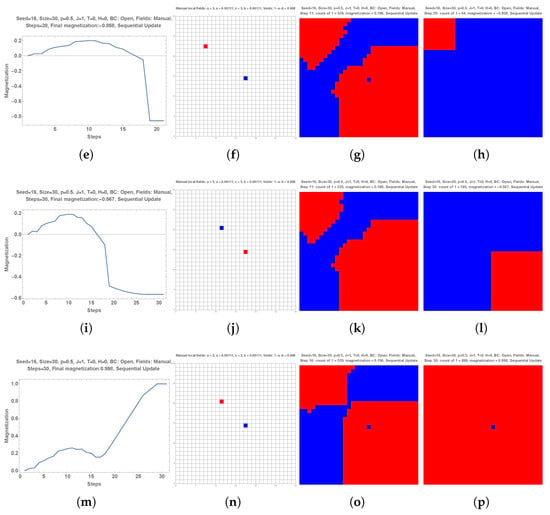
Figure 1.
A simulation with an initial configuration with half +1 and half (, subpart (b)) without local fields. The dynamics are shown as a function of MC steps in subpart (a). The +1 choice gains increased support until about 10 MC steps and then starts losing support before shrinking to zero within only a few MC steps. Subpart (c) shows the existence of two domains with A being the majority (485 + 1 vs. 415 − 1) after the completion of 15 MC steps. A few more MC steps leads to an unexpected total victory (spontaneous symmetry breaking) of B as seen in subpart (d). In the second row two local opposite fields have been added in subpart (f). The associated dynamics is shown in subpart (e). More MC steps keeps A as the majority (subpart (g)). The final outcome has a small A domain (subpart (h)). In the third row the locations of the red and blue local fields have been shifted (subpart (j)). The results are similar to the above ones with now two separate red domains separated by a blue domain (subpart (k)). The final small A domain is in the lower right part of the grid (subpart (l)). In the fourth row the field colors have been swapped (subpart (n)). During the first 15 MC steps, the dynamics (subparts (m,o)) are similar to subparts (i,k). However, after the beginning of the decrease, instead of a red shrinking, the red is boosted at once to invade the full sample (subpart (p)).
The second row of Figure 1 shows the same simulation, except that it has two local opposite fields shown in subpart (f). These two local fields enlarged the number of MC, with A being the majority as illustrated in subpart (g) with 539 + 1. The final outcome now keeps a small A domain (subpart (h)).
The third row keeps the second row setting with a shift in the locations of the red and blue local fields (subpart (j)). The results are similar to the above ones with now two separate red domains separated by a blue domain (subpart (k)). The final small A domain is in the lower right part of the grid (subpart (l)).
However, the fourth row shows an unexpected outcome. The unique difference with the third row is the swapping of the field colors. During the first 15 MC steps, the dynamics are similar to subpart (i). However, after, instead of a red shrinking, the red is boosted at once to invade the full sample.
4.1.2. Effect of Two Pairs of Opposite Local Fields
Figure 2 uses the same initial distribution of red and blue sites from subpart (b) of Figure 1 with the addition of two red and two blue local fields located in the upper left part of the grid. Four very similar field locations are used as shown in subparts (b,e,h,k). Respective dynamics are exhibited in subparts (a,d,g,j). Subparts (c,f,i,l) show the related final outcomes with drastic contrasts in the winning color. The results illustrate the fragility of the final state against the application of two local fields at strategic locations. This fact reveals the vulnerability of a completely broken symmetry in the face of just two well-positioned local fields.
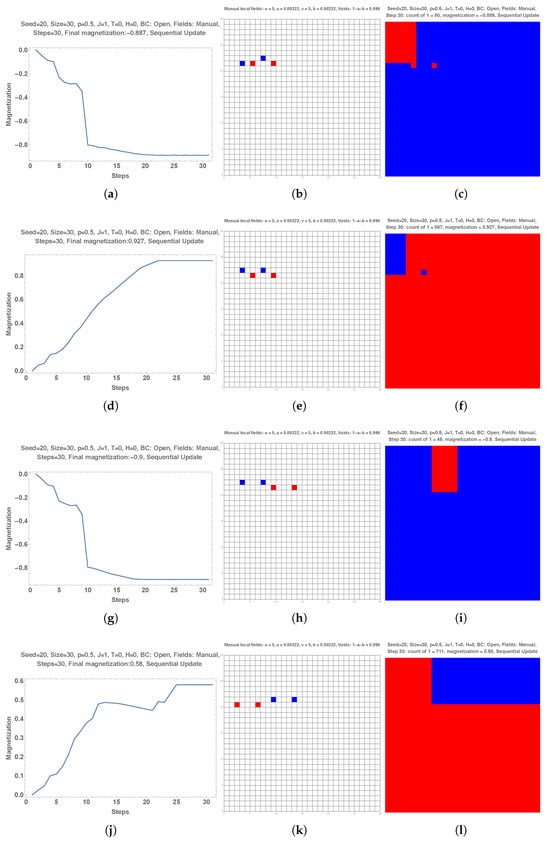
Figure 2.
Same initial distribution of red and blue sites as in subpart (b) of Figure 1. Two red and two blue local fields are applied. Subparts (b,e,h,k) show four different field locations. Respective dynamics are exhibited in subparts (a,d,g,j). Subparts (c,f,i,l) show the related final outcomes. This fact reveals the vulnerability of a completely broken symmetry in the face of just two well-positioned local fields.
4.1.3. Effect of Equal Proportions (0.15 and 0.25) of Blue and Red Local Fields
The above results have revealed a fragility in the dynamics of spontaneous symmetry breaking associated with just two local fields located at given tipping sites. The effect was found to be of a hazardous nature due to the difficulty in identifying the location of those tipping sites.
To overcome this flaw, I ran two simulations with large and equal proportions of red and blue local fields, 0.15 and 0.25, respectively, as shown in subparts (a,d) of Figure 3. Subparts (b,c,e,f) exhibit the related dynamics for two different initial distributions of initial choices with . Yet the outcome is still random with strong fluctuations with respect to the winning majority as seen in the subparts.

Figure 3.
Simulations with proportions of red and blue local fields shown in subparts (a,d). Subparts (b,c,e,f) exhibit the related dynamics for two different initial distributions of initial choices with . Yet the outcome is still random with strong fluctuations with respect to the winning majority as seen in the subparts.
4.2. Asymmetric Initial Configuration and Local Fields
4.2.1. Effect of Small Differences (0.01 and 0.02) of Proportions Between Blue and Red Local Fields
I now investigate asymmetric cases, first in the proportions of red and blue local fields still with equal proportions of red and blue initial choices.
Subpart (a) of Figure 4 shows a distribution and of red and blue fields with two different distributions of initial choices. The related dynamics are shown in subparts (b,c). Subpart (d) has and with the dynamics shown in subparts (e,f).
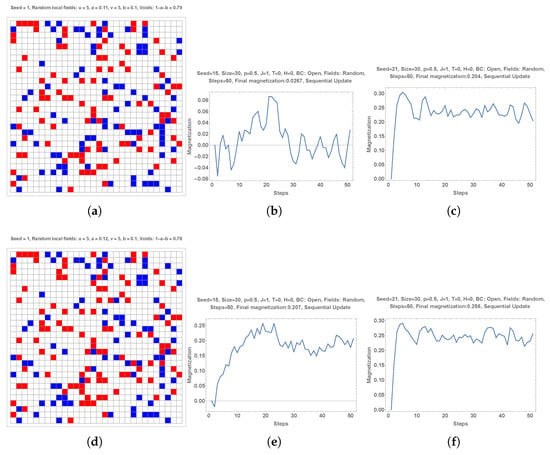
Figure 4.
Subpart (a) shows a distribution and of red and blue fields with two different distributions of initial choices. The related dynamics are shown in subparts (b,c). Subpart (d) has and with the associated dynamics shown in subparts (e,f). While an extra 1% of red fields ensure a red majority for one initial distribution (subpart (c)), it does not in the other (subpart (b)). In contrast, subparts (d–f) show that an extra 2% ensures a red victory in both cases.
While an extra 1% of red fields ensures a red majority for one initial distribution (subpart (c)), it does not in the other (subpart (b)).
In contrast, subparts (d–f) show that an extra 2% ensures a red victory in both cases.
4.2.2. Effect of One Side Red Local Fields (0.15, 0.09 and 0.08)
All the above cases start from a balanced initial distribution (). Some differ in terms of red and blue site locations. Each specific distribution is identified by the Seed parameter to ensure tracking. The goal was to investigate the distortion of the expected spontaneous symmetry breaking by applying some local breaking fields.
In the following cases I start with a totally broken initial distribution where all sites are blue () to identity the possibility to reverse the collective blue choice. To this end, I apply only red local fields.
Figure 5 shows three cases with for the density of red local fields. The related locations are seen in subparts (b,e,h). Locations are random in the first three and selected in the last one. Associated dynamics are exhibited in subparts (a,d,g). Subpart (c) shows the grid after six MC steps before it turns entirely red after about 15 MC steps. Subparts (f) with show the same final grid as for . However, with one percent less in the proportion of the local red field (), the reversal from complete blue to complete red is lost as illustrated by subpart (i).

Figure 5.
Three cases with for the density of red local fields. The related locations are seen in subparts (b,e,h). Locations are random in the first three and selected in the last one. Associated dynamics are exhibited in subparts (a,d,g). Subpart (c) shows the grid after six MC steps before it turns entirely red after about 15 MC steps. Subparts (f) with show the same final grid as for . A one percent reduction in the proportion of the local red field () results in the loss of the reversal from complete blue to complete red as illustrated by subpart (i).
4.2.3. Effect of Low Similar Proportions of One Side Red Local Fields (0.02, 0.033 and 0.034)
Figure 6 shows red local fields applied at selected locations. Three cases are exhibited with 18 (subpart (b), ), 30 (subpart (e), ) and 31 (subpart (h), ) red local fields. Associated dynamics are shown in subparts (a,d,g), Final outcomes are shown in subparts (c,f,i) with 136, 116 and 530 red choices, respectively, among the 900 choices. Again, one additional single local field located at a given tipping site is found to have a substantial impact on the final outcome with the creation of a large majority of 530 red choices against a minority of 116 previously.
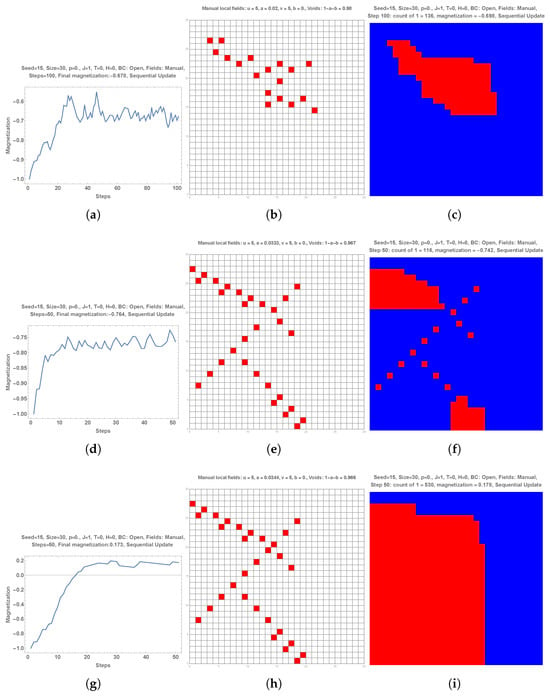
Figure 6.
Red local fields are applied at selected locations: 18 in subpart (b), 30 in subpart (e), 31 in subpart (h). Associated dynamics are shown in subparts (a,d,g), and final outcomes are shown in subparts (c,f,i) with 136, 116 and 530 red choices, respectively. The last two cases show that a single local field (from 30 to 31) located at a given tipping site has a substantial impact on the final outcome with a large majority of 530 red choices against a minority of 116.
4.3. Effect of One Single Well Located Local Field
4.3.1. Effect of One Single Red Local Field as a Function of Different Distributions of the Same Proportions (Fifty–Fifty) of Initial Red and Blue Choices
Subparts (m,n,o,p) of Figure 1 suggest that one single red local field located at a specific site of a distribution of equal proportions of red and blue colors () should distort the related spontaneous blue symmetry breaking towards a red total symmetry breaking. The prediction is confirmed by subparts (a–d) of Figure 7.
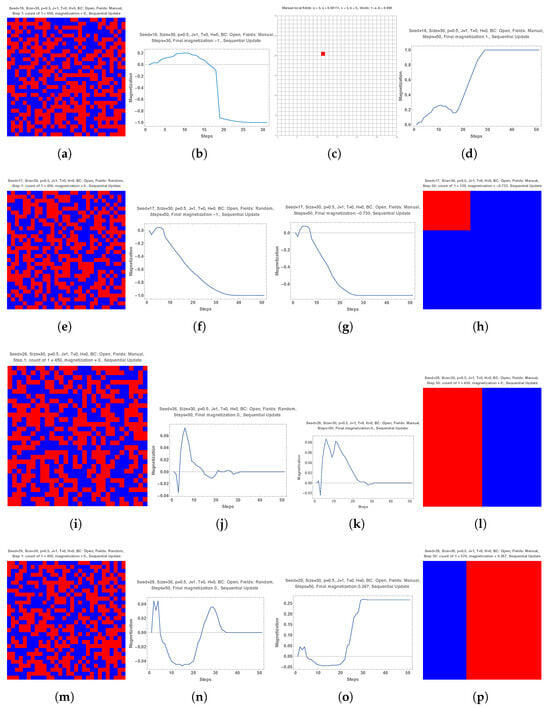
Figure 7.
Subparts (a–d) show that one single red local field located at a specific site of a distribution of equal proportions of red and blue colors (Seed = 16, ) distorts the related spontaneous blue symmetry breaking towards a red total symmetry breaking. Subpart (e) shows a different initial distribution of choices (Seed = 17), while subpart (f) exhibits the associated dynamics of symmetry breaking towards blue unanimity. Adding the subpart (c) local red field modifies the dynamics with a stabilization of minority red domains as seen in subparts (g,h). Subpart (i) shows another different initial distribution of choices (Seed = 26) leading to a stabilization of two equal red and blue domains as seen in subpart (j). Here, applying the red local field modifies the dynamics but preserves the final coexistence of two equal domains as shown in subparts (k,l). Subpart (m) shows another initial distribution leading again to a stabilization of two equal red and blue domains (subpart (n)). However, now the red local field produces a majority of red choices as seen from subparts (o,p).
Subpart (e) shows a different initial distribution of choices (Seed = 17), while subpart (f) exhibits the associated dynamics of symmetry breaking towards blue unanimity. Adding the subpart (c) local red field modifies the dynamics with a stabilization of minority red domains as seen in subparts (g,h).
Subpart (i) shows another different initial distribution of choices (Seed = 26) leading to a stabilization of two equal red and blue domains as seen in subpart (j). Here, applying the red local field modifies the dynamics but preserves the final coexistence of two equal domains as shown in subparts (k,l).
Subpart (m) shows another initial distribution leading again to a stabilization of two equal red and blue domains (subpart (n)). However, now the red local field produces a majority of red choices as seen from subparts (o,p).
4.3.2. Effect of One Single Local Field with Different Proportions of Initial Red and Blue Choices (0, 0.44 and 0.45 Red Fields)
Figure 7 shows the substantial impact that one single well positioned red local field can have on the dynamics of interactions among initial distributions of red and blue choices with . Figure 8 revisits the effect starting from initial configurations with .

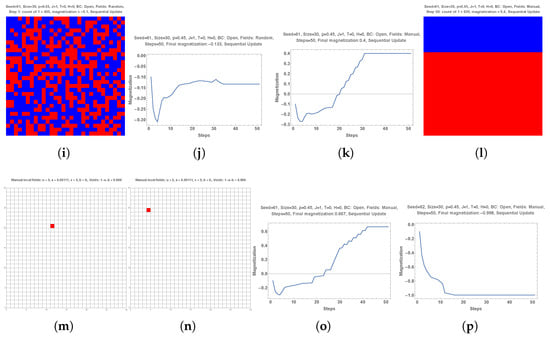
Figure 8.
Respective subparts (a,b,c,d), (e,f,g,h), (i,j,k,l) have a single red local field located at the same position as in Figure 8. Zero effect is seen when starting from as could be expected (subparts (a–d)). Subpart (e) shows an initial configuration with and the related dynamics in subparts (f,g), zero and one local field, respectively. Very little effect is observed with the same final state (subpart (h)) as with . With a one percent increase in red initial choices from to (subpart (i)), the single red local field is found to have quite a strong impact with a final majority domain with 630 red choices as seen in subparts (j–l). The last row shows the effect of only one single red local field but located at a different position on the grid as seen in subpart (m) with the previous coalition and subpart (n) with the new location. Subpart (o) shows the associated dynamics with the same initial distribution (Seed = 61, ) and subpart (p) with a different initial distribution (Seed = 62, ). While the new location of the red single field increases the support for red choices in the final outcome as seen comparing subparts (o,k), it has zero effect on the second distribution as shown in subpart (p).
Respective subparts (a,b,c,d), (e,f,g,h) and (i,j,k,l) keep the single red local field located at the same position. Zero effect is seen when starting from as could be expected (subparts (a–d)).
Subpart (e) shows an initial configuration with . Subparts (f,g) shows the dynamics of interactions with zero and one local field, respectively. Very little effect is observed with the same final state (subpart (h)) as with .
However, with a one percent increase in red initial choices from to (subpart (i)), the single red local field is found to have quite a strong impact with a final majority domain with 630 red choices as seen in subparts (j–l).
The last row shows the effect of only one single red local field but located at a different position on the grid as seen in subpart (m) with the previous coalition and subpart (n) with the new location. Subpart (o) shows the associated dynamics with the same initial distribution (Seed = 61, ) and subpart (p) with a different initial distribution (Seed = 62, ). While the new location of the red single field increases the support for red choices in the final outcome as seen comparing subparts (o) and (k), it has zero effect on the second distribution as shown in subpart (p).
4.3.3. Random vs. Sequential Updates
To end the Monte Carlo exploration, which was performed using a sequential update, I consider in Figure 9 a few cases using a random update to demonstrate that similar qualitative results are obtained, dismissing the possibility that they could have been artifacts of the sequential update. However, for the same initial conditions, sequential and random updates do yield different quantitative final states.
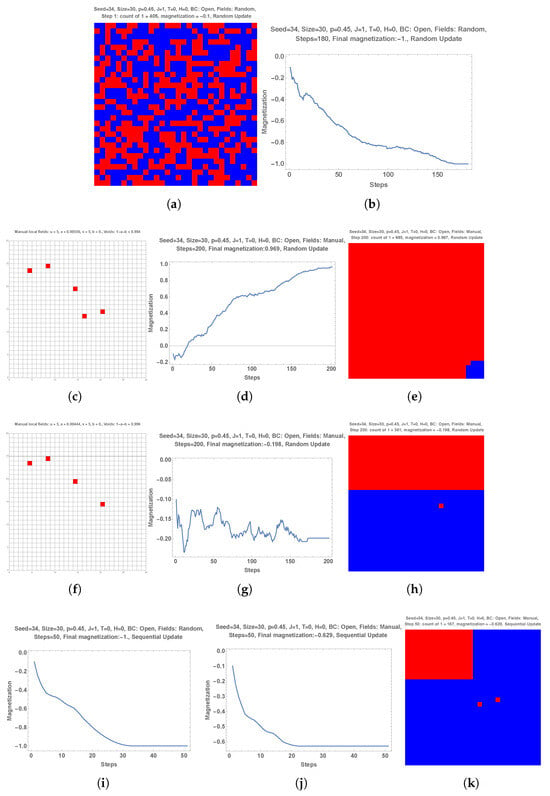
Figure 9.
Subpart (a) shows an initial distribution of red and blue choices with with Seed = 34. Subpart (b) shows the dynamics of interactions leading to an overwhelming majority of blue choices. Six red local fields located at specific sites (subpart (c)) reverse the final outcome with a huge majority of red choices after 200 MC steps as seen from subparts (d,e). In contrast, erasing one red local field (subpart (f)) restores a blue majority as shown in subparts (g,h). Applying a sequential update to the distribution of subpart (a) without local fields more quickly yields a similar outcome as illustrated with subparts (i,b). Applying the six local fields of subpart (c) does not yield a red majority as seen from subparts (j,k).
Subpart (a) shows an initial distribution of red and blue choices with as in subparts (i–p) of Figure 8. However, actual distributions are different with Seed = 34 here and Seed = 62 in subpart (p) as well as Seed = 61 in Figure 8. Subpart (b) shows the dynamics of interactions leading to an overwhelming majority of blue choices.
Unlike previous cases with one single red local field, six red local fields are applied at specific sites (subpart (c)) to reverse the final outcome with a huge majority of red choices after 200 MC steps as seen from subparts (d,e).
In contrast, erasing one red local field (subpart(f)) restores a blue majority as shown in subparts (g,h).
Yet applying a sequential update to the distribution of subpart (a) without local fields yields a similar outcome as illustrated with subpart (i) in contrast to subpart (b). However, 30 MC steps are sufficient to obtain full blue symmetry breaking against 150 with random update.
Yet applying the six local fields of subpart (c) does not yield a red majority as seen from subparts (j,k).
5. Exploring the Impact of Group Sizes
While all simulations were limited to a grid, below I add the results of a series of simulations with larger sizes, including , , and . All have an equal proportion of red and blue choices . The results are shown below in Figure 10 and Figure 11.
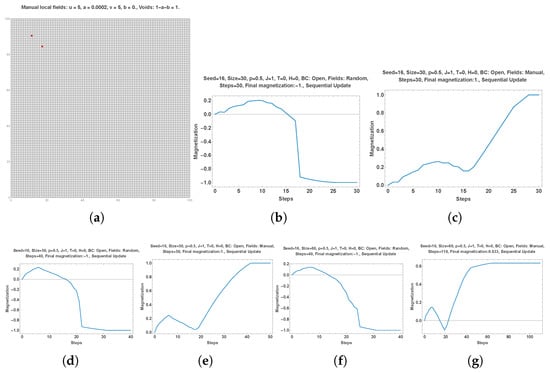

Figure 10.
Starting with a grid, the size is increased by adding two strips on its right side and below. To move to a a vertical strip of size is added on the right side and a horizontal strip of size below the grid. The same process applies for moving to the other sizes. The initial distribution of choices satisfies for all sizes. Two red local fields are included on the grid as shown in subpart (a) where the vertical counting is reversed going from 100-70 to 100-40 and so on. For each size, the subpart with “Fields: Random” shows the final outcome with no local fields and the subpart with “Fields: Manual” shows the final outcome with the two red local fields shown in subpart (a). With no local fields a symmetry breaking occurs along the blue choice for sizes , and as seen in subparts (b,d,f), while the two local red fields are found to totally reverse the symmetry breaking from full blue to full red as seen in subparts (c,e,g). For , the symmetry breaking is no longer totally blue (subpart (h)), but the two red local fields still drive a full red alignment (subpart (i)). The situation changes for , with a full red alignment with and without fields as seen from subparts (j,k).
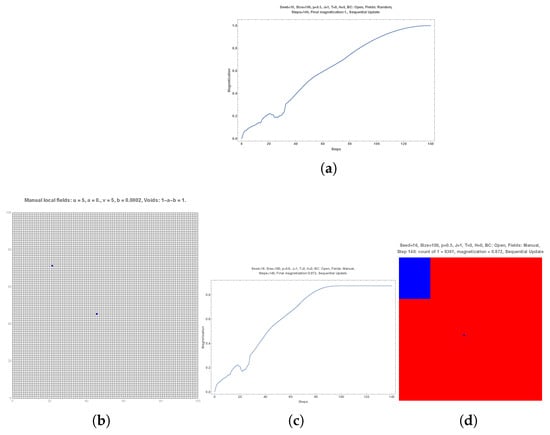
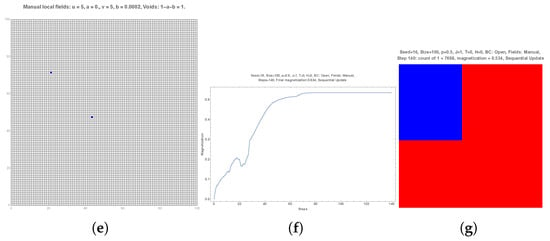
Figure 11.
A grid yielding a full red alignment without local fields is shown in subpart (a). Subparts (b,e) show two blue local fields located as slightly different sites for one of them. In the first case the final state has a coexistence of a very large red domain with a small blue one as exhibited in subparts (c,d). However a substantial increase in the precedent red domain is obtained for the second case as seen in subparts (f,g).
I first explore the size effect by starting with a grid. I then increase it size by adding two strips on its right side and below. To move to a grid, I thus add a vertical strip of size on the right side and a horizontal strip of size below. I thus preserve the initial distribution of choices in the first grid and keeps . I repeat the same procedure to move to , and .
In Figure 10 I include two red local fields, which I keep fixed when increasing the size as shown in subpart (a) where the vertical counting is reversed going from 100–70 to 100–40 and so on.
For each size, the subpart with “Fields: Random” shows the final outcome with no local fields and the subpart with “Fields: Manual” shows the final outcome with the two red local fields shown in subpart (a).
With no local fields a symmetry breaking occurs along the blue choice for sizes , and as seen in subparts (b,d,f), while the two local red fields are found to totally reverse the symmetry breaking from full blue to full red as seen in subparts (c,e,g).
For , the symmetry breaking is no longer totally blue (subpart (h)), but the two red local fields still drive a full red alignment (subpart (i)). The situation changes for , with a full red alignment with and without fields as seen from subparts (j,k).
Figure 11 considers a grid yielding a full red alignment without local fields (subpart (a)). However, I now include two blue local fields located at different positions as shown in subparts (b,e). in the first case the final state has a coexistence of a very large red domain with a small blue one as exhibited in subparts (c,d). However subpart (e) exhibits a small move for one blue local site, yielding a substantial increase in the precedent red domain as seen in subparts (f,g).
The above results have reproduced the mean qualitative features obtained for the grid . In particular, the existence of tipping sites has been confirmed. Although at this stage, identifying their respective locations given an initial distribution of choices is a challenge, which has been addressed by trial and error. A systematic protocol would require massive numerical resources, which are beyond the scope of the present paper. Yet having proved their existence is a first meaningful step.
6. Discussion
This paper is a follow-up of a previous work [6], which explored finite size effects for the 2-d Ising model with no field, neither external not local, the claim being that for social applications, systems are often of finite sizes, which make some of the related effects, otherwise considered as artifacts for physical systems, relevant.
The main focus of the paper is to show with a simple and transparent model how minimal interventions can revert collective outcomes of opinion dynamics in a small community of agents. The novelty lies in the clean demonstration that spontaneous polarization is extremely fragile against a very small uniform field, which fixes its direction. In addition, a handful of well-placed local fields can flip or fragment the final state.
A small field is created by an external social pressure exerted on all members of a community. That can be achieved via advertising and large scale campaigns. In contrast, local fields are produced using targeted individual pressures, for instance, via social media.
The careful exploration of the impact of single-site and two-site bias with local fields has revealed the disproportionate global impact of tipping sites. Tipping sites are sites for which their respective locations allow an unexpected leverage on the final collective choices, which is obtained through the update of opinions.
The tipping sites when activated by a local field behave like structural weak points. They are indistinguishable from others yet capable of redirecting the evolution of the whole system. Much like a crack in a material [72] or a mutation in a biological network [73], these localized vulnerabilities magnify small perturbations into large-scale outcomes, highlighting both the strength and fragility inherent to related dynamics in such configurations.
It is important to stress that these locations vary as a function of the initial distribution of individual choices. The sensitivity of the outcomes to initial conditions has been illustrated in the first paper to which this work relates, similarly to the impact of alternative updates such as synchronous updates.
I notice that formally the model turns out to be identical to the RFIM. The novelties are related to identifying the various scenarios obtained for finite size systems for which the final outcomes are connected to the history of the updates as well as the update scheme being used. In the thermodynamic limit, all these findings disappear to recover the RFIM results. Differences are found through running simulations. At the mean-field level basic observables are identical to those of the RFIM.
At this stage the purpose is not to establish a direct link to empirical data but to uncover possible new paths, which could be at work in driving the transformation of a minority into a majority within opinion dynamics. I hope the results obtained using a stylized model will stimulate researchers working with data to explore these new options.
From my current investigation the probability of a site being a tipping site is of measure zero. What matters at this stage of the investigation is to have uncovered the existence of such tipping sites. A systematic search to achieve solid statistics would require enormous numerical calculations, which are beyond my capacity. Such a task is also beyond the current scope of the paper.
At this stage I do hope my paper will trigger some further works to address this important practical issue. However, this is an important point, and I have added a paragraph about it.
7. Conclusions
In this paper I have shown how spontaneous symmetry breaking is vulnerable to even minimal distortions of randomness with disproportionate consequences. A handful of local fields, when positioned at tipping sites, were found to be decisive in steering the entire system. This dual nature, strength in effect but fragility in position, underscores the system’s sensitivity to localized quenched local fields in the process of symmetry breaking. The tipping sites when activated by a local field are indistinguishable from others yet capable of redirecting the evolution of the whole system.
The distinction between spontaneous and distorted polarization provides a useful lens for interpreting this vulnerability. In the model, spontaneous polarization arises from internal interactions without a preferred direction, reflecting the natural symmetry-breaking tendency of the system whose direction is randomly selected. Indeed, it is a function of the actual distribution of initial local choices and the update scheme being implemented.
Distorted polarization, by contrast, emerges when invisible manipulation implemented by external local fields or internal local biases are activated at these fragile sites, producing directed stable configurations. This dynamic highlights how minimal interventions can lock a system into trajectories that obscure its underlying capacity for autonomous self-organization. Interventions do not need to be strong. They only need to exploit existing geometrical vulnerabilities to override the system’s capacity for spontaneous random symmetry breaking.
The results expose a fundamental tension in Ising-like models of opinion dynamics. In the absence of local bias, the system can undergo spontaneous symmetry breaking, leading to large-scale consensus or polarization generated by stochastic fluctuations and local coupling alone. Yet when a handful of local fields are applied, whether external (media influence and institutional pressure) or internal (individual biases, beliefs and prejudices), these vulnerable tipping sites, when activated with local fields, amplify their effect, producing directed polarization that reduces the system’s intrinsic variability.
This mechanism resonates with real-world social systems, where opinion formation reflects both endogenous dynamics and exogenous constraints. Recognizing how fragility at local scales enables disproportionate global control is essential for interpreting consensus and division, in both physical models and socio-political contexts.
In the end, consensus is not always self-organization. It may be symmetrically broken under a hidden constraint deliberately shaped and strategically imposed by one of the competing sides. Those findings may open a new critical view of the nature of social media. Although obtained within a two-dimensional Ising-like model, the results invite a critical reassessment of the so-called “democratic” character of social media. They may shed new light on hidden limitations within social media platforms, which subtly guide and sometimes even dictate the direction of ostensibly “spontaneous” democratic collective choices.
Funding
This research received no external funding.
Data Availability Statement
All data are included in the paper. Further inquiries can be directed to the corresponding author.
Conflicts of Interest
The author declares no conflicts of interest.
References
- Ma, S.-K. Modern Theory of Critical Phenomena; The Benjamin Inc.: Reading, MA, USA, 1976. [Google Scholar]
- Stanley, H.E. Introduction to Phase Transitions and Critical Phenomena; Oxford University Press: Oxford, UK, 1971. [Google Scholar]
- Ising, E. Beitrag zur Theorie des Ferromagnetismus. Z. Phys. 1925, 31, 253–258. [Google Scholar] [CrossRef]
- Onsager, L. Crystal Statistics. I. A Two-Dimensional Model with an Order-Disorder Transition. Phys. Rev. 1944, 65, 117. [Google Scholar] [CrossRef]
- Stauffer, D. Social applications of two-dimensional Ising models, Social Applications of Two-dimensional Ising Models. Am. J. Phys. 2008, 76, 470–473. [Google Scholar] [CrossRef]
- Galam, S. Spontaneous Symmetry Breaking, Group Decision-Making, and Beyond: 1. Echo Chambers and Random Polarization. Symmetry 2024, 16, 1566. [Google Scholar] [CrossRef]
- Timpanaro, A.M. Emergence of echo chambers in a noisy adaptive voter model. arXiv 2024, arXiv:2409.12933v1. [Google Scholar]
- Walter, J.C.; Barkema, G.T. An introduction to Monte Carlo methods. Phys. A Stat. Mech. Appl. 2015, 418, 78–87. [Google Scholar] [CrossRef]
- Takano, H. On Monte Carlo Methods for the Kinetic Ising Model. J. Phys. Soc. Jpn. 1993, 62, 370–371. [Google Scholar] [CrossRef]
- Binder, K.; Heermann, D.W. Monte Carlo Simulation in Statistical Physics; Springer: Berlin/Heidelberg, Germany, 2010. [Google Scholar]
- Galam, S.; Moscovici, S. Towards a theory of collective phenomena: Consensus and attitude changes in groups. Eur. J. Soc. Psychol. 1991, 21, 49–74. [Google Scholar] [CrossRef]
- Galam, S. Rational group decision making: A random field ising model at T = 0. Phys. A 1997, 238, 66–80. [Google Scholar] [CrossRef]
- Sun, X.; Guo, B.; Yang, Y.; Pan, Y. Time for a change! Uprooting users embedded in the status quo from habitual decision-making. Decis. Support Syst. 2025, 189, 114371. [Google Scholar] [CrossRef]
- Brazil, R. The Physics of Public Opinion, Physics World. January Issue. 2020. Available online: https://physicsworld.com/a/the-physics-of-public-opinion/ (accessed on 1 September 2025).
- Brazil, R. Borrowing Scientific Theories, Chemistry World, November Issue. 2019. Available online: https://www.chemistryworld.com/features/borrowing-scientific-theories/3010929.article (accessed on 1 September 2025).
- Maksymov, I.S. Cognition in Superposition: Quantum Models in AI, Finance, Defence, Gaming and Collective Behaviour. arXiv 2025, arXiv:2508.20098. [Google Scholar]
- Bonetti, A.; Martino, E.D.; Loru, E.; Nudo, J.; Pandolfo, M.E.; Quattrociocchi, W. Patterns, Models, and Challenges in Online Social Media: A Survey. arXiv 2025, arXiv:2507.13379. [Google Scholar]
- Marques, A.S.; Santos, A.P.d.; da Rosa, R.C.; Bordin, J.R.R. The Physics of Getting Elected: Financial Dynamics in Local Council Elections in Brazil; SSRN: Rochester, NY, USA, 2025; p. 5382183. [Google Scholar]
- Xu, G.; Chen, J.; Zhou, X.; Wang, Y. Phase transitions in voting simulated by an intelligent Ising model. arXiv 2025, arXiv:2507.19161. [Google Scholar] [CrossRef]
- Domenico, F.D.; Caccioli, F.; Livan, G. Peer influence breaks ergodicity in an opinion dynamics model with external information. arXiv 2025, arXiv:2507.06661v2. [Google Scholar] [CrossRef]
- Xiao, Y.-W.; Guo, W.-C.; Ai, B.-Q.; He, L. Barrier induced stalemate-consensus transition of self-propelled participants subject to majority rule. arXiv 2025, arXiv:2505.03464v2. [Google Scholar]
- Hase, M.O.; Ferreira, A.A.; Martins, A.C.R.; Ferreira, F.F. Annealing Approximation in Master-Node Network Model. arXiv 2025, arXiv:2505.03150. [Google Scholar] [CrossRef]
- Malarz, K.; Woloszyn, M. Fine structure of phase diagram for social impact theory. Chaos 2025, 35, 063103. [Google Scholar] [CrossRef]
- Pradhan, A.; Mullick, P.; Sen, P. Analysing contrarian behaviour using nonlinear biased q-voter model. arXiv 2025, arXiv:2509.01982. [Google Scholar]
- Doniec, M.; Sen, P.M.P.; Sznajd-Weron, K. Modeling biases in binary decision-making within the generalized nonlinear q-voter model. Chaos 2025, 35, 043133. [Google Scholar] [CrossRef]
- Starnini, M.; Baumann, F.; Galla, T.; Garcia, D.; Iǹiguez, G.; Karsai, M.; Lorenz, J.; Sznajd-Weron, K. Opinion dynamics: Statistical physics and beyond. arXiv 2025, arXiv:2507.11521. [Google Scholar] [CrossRef]
- Rotundo, G.; Cerqueti, R.; Dhesi, G.; Herteliu, C.; Kaur, P.; Ausloos, M. Hybrid Galam-Bass Model for Technology Innovation. Entropy 2025, 27, 789. [Google Scholar] [CrossRef]
- Galam, S. Ambiguities, Built-in Biases and Flaws in Big Data Insight Extraction. Information 2025, 16, 661. [Google Scholar] [CrossRef]
- de Almeida, R.G.; Arenzon, J.J.; Corberi, F.; Dantas, W.G.; Smaldone, L. Coarsening in the Persistent Voter Model: Analytical results. Phys. Rev. E 2025, 111, 064313. [Google Scholar] [CrossRef] [PubMed]
- Biswas, S.; Annapurna, M.S.; Jakkampudi, V.; Yarlagadda, D.; Thota, B. Order-disorder-order transitions and winning margins scaling in kinetic exchange opinion model. arXiv 2025, arXiv:2508.06237. [Google Scholar] [CrossRef]
- Sevinchan, Y.; Sarkanych, P.; Tenenbaum, A.; Holovatch, Y.; Romanczuk, P. Collective decision-making with heterogeneous biases: Role of network topology and susceptibility. Phys. Rev. Res. 2025, 7, 013286. [Google Scholar] [CrossRef]
- Almudi, I.; Fatas-Villafranca, F.; Vázquez, F.J. The evolutionary political economy of dichotomized societies. J. Evol. Econ. 2025, 35, 173–206. [Google Scholar] [CrossRef]
- Crokidakis, N. Dynamics of drug trafficking: Results from a simple compartmental model. Int. J. Mod. Phys. C 2025, 36, 2450201. [Google Scholar] [CrossRef]
- Dornelas, D.; Anteneodo, C.; Nunes, R.; Heinsalu, E.; Patriarca, M. Role of zealots in the spread of linguistic traits. Phys. Rev. E 2025, 112, 044303. [Google Scholar] [CrossRef]
- Villaseǹor-Ibàǹez, J.; del Castillo-Mussot, M.; Deeb, O.E. Religion or class? Measuring voting clustering on religious and socioeconomic lines in US presidential elections. PLoS ONE 2025, 20, e0331959. [Google Scholar] [CrossRef] [PubMed]
- Na, X.; Liu, H.; Xu, S.; Su, C.; Sun, J.; Zhang, W.; Lü, L. Myopic vs. farsighted behaviors: The impact of platform bias on the matching system stability and platform sustainability. Chaos Solitons Fractals 2025, 199, 116781. [Google Scholar] [CrossRef]
- Ermann, L.; Shepelyansky, D.L. Confrontation of Capitalism and Socialism in Wikipedia Networks. Information 2024, 15, 571. [Google Scholar] [CrossRef]
- Oliveira, I.V.G.; Wang, C.; Dong, G.; Du, R.; Fiore, C.E.; Vilela, A.L.; Stanley, H.E. Entropy Production on Cooperative Opinion Dynamics. Chaos, Solitons Fractals 2024, 181, 114694. [Google Scholar] [CrossRef]
- Mori, S.; Nakamura, S.; Nakayama, K.; Hisakado, M. Phase Transition in Ant Colony Optimization. Physics 2024, 6, 123–137. [Google Scholar] [CrossRef]
- Kaufman, M.; Kaufman, S.; Diep, H.T. Social Depolarization: Blume-Capel Model. Physics 2024, 6, 138–147. [Google Scholar] [CrossRef]
- Muslim, R.; Mulya, D.A. The impact of social noise on the majority rule model across various network topologies. Chaos Solitons Fractals 2024, 189, 115718. [Google Scholar] [CrossRef]
- Zhang, H.B.; Tang, D.P. Effects of group size and noise on cooperation in population evolution of dynamic groups. Eur. Phys. J. B 2024, 97, 150. [Google Scholar] [CrossRef]
- Martins, A.C.R. Agent Mental Models and Bayesian Rules as a Tool to Create Opinion Dynamics Models. Physics 2024, 6, 1013–1031. [Google Scholar] [CrossRef]
- Palermo, G.; Mancini, A.; Desiderio, A.; Clemente, R.D.; Cimini, G. Spontaneous opinion swings in the voter model with latency. Phys. Rev. E. 2024, 110, 024313. [Google Scholar] [CrossRef] [PubMed]
- Crokidakis, N. Nonequilibrium phase transitions and absorbing states in a model for the dynamics of religious affiliation. Phys. A 2024, 643, 129820. [Google Scholar] [CrossRef]
- Liu, X.H.; Achterberg, M.A.; Kooij, R. Mean-field dynamics of the non-consensus opinion model. Appl. Netw. Sci. 2024, 9, 47. [Google Scholar] [CrossRef]
- Liu, W.; Wang, J.C.; Wang, F.F.; Qi, K.K.; Di, Z.R. The precursor of the critical transitions in majority vote model with the noise feedback from the vote layer. J. Stat. Mech. 2024, 2024, 083402. [Google Scholar] [CrossRef]
- Forgerini, F.L.; Fabricio, L.; Crokidakis, N.; Carvalho, M.A.V. Directed propaganda in the majority-rule model, nt. J. Mod. Phys. C 2024, 35, 2450082. [Google Scholar] [CrossRef]
- Malarz, K.; Maslyk, T. Phase Diagram for Social Impact Theory in Initially Fully Differentiated Society. Physics 2024, 5, 1031–1047. [Google Scholar] [CrossRef]
- Toth, G. Models of opinion dynamics with random parametrisation. J. Math. Phys. 2024, 65, 073301. [Google Scholar] [CrossRef]
- Maksymov, I.S.; Pogrebna, G. The Physics of Preference: Unravelling Imprecision of Human Preferences through Magnetisation Dynamics. Information 2024, 15, 413. [Google Scholar] [CrossRef]
- Santen, N.V.; Ryckebusch, J.; Rocha, L.E.C. Social clustering reinforces external influence on the majority opinion model. Phys. A 2024, 648, 129929. [Google Scholar] [CrossRef]
- Ausloos, M.; Rotundo, G.; Cerqueti, R. A Theory of Best Choice Selection through Objective Arguments Grounded in Linear Response Theory Concepts. Physics 2024, 6, 468–482. [Google Scholar] [CrossRef]
- Llabrès, J.; Oliver-Bonafoux, S.; Anteneodo, C.; Toral, R. Aging in Some Opinion Formation Models: A Comparative Study. Physics 2024, 6, 515–528. [Google Scholar] [CrossRef]
- Azhari, R. Muslim, The external field effect on the opinion formation based on the majority rule and the q-voter models on the complete graph. Int. J. Mod. Phys. C 2023, 34, 2350088. [Google Scholar] [CrossRef]
- Li, S.; Zehmakan, A.N. Graph-Based Generalization of Galam Model: Convergence Time and Influential Nodes. Physics 2023, 5, 1094–1108. [Google Scholar] [CrossRef]
- Thurner, S. New Forms of Collaboration Between the Social and Natural Sciences Could Become Necessary for Understanding Rapid Collective Transitions in Social Systems. Perspect Psychol Sci. 2024, 19, 503–510. [Google Scholar] [CrossRef]
- Ellero, A.; Fasano, G.; Favaretto, D. Mathematical Programming for the Dynamics of Opinion Diffusion. Physics 2023, 5, 936–951. [Google Scholar] [CrossRef]
- Alves, E.; Lima, F.W.; Alves, T.F.A.; Tayroni, F.A.; Alves, G.D.; Plascak, J.A. Opinion Dynamics Systems via Biswas-Chatterjee-Sen Model on Solomon Networks. Physics 2023, 5, 873–882. [Google Scholar]
- Mobilia, M. Polarization and Consensus in a Voter Model under Time-Fluctuating Influences. Physics 2023, 5, 517–536. [Google Scholar] [CrossRef]
- Galam, S. Unanimity, Coexistence, and Rigidity: Three Sides of Polarization. Entropy 2023, 25, 622. [Google Scholar] [CrossRef] [PubMed]
- Galam, S.; Gefen, Y.; Shapir, Y. Sociophysics: A new approach of sociological collective behavior. J. Math. Sociol. 1982, 9, 1. [Google Scholar] [CrossRef]
- Tiwari, M.; Yang, X.; Sen, S. Modeling the nonlinear effects of opinion kinematics in elections: A simple Ising model with random field based study. Phys. A 2021, 582, 126287. [Google Scholar] [CrossRef]
- Macy, M.W.; Szymanski, B.K.; Holyst, J.A. The Ising model celebrates a century of interdisciplinary contributions. NPJ Complex. 2024, 1, 10. [Google Scholar] [CrossRef]
- Hurtado-Marin, V.A.; Agudelo-Giraldo, J.D.; Restrepo-Parra, E. Analysis of dynamic networks based on the Ising model for the case of study of co-authorship of scientific articles. Sci. Rep. 2021, 11, 5721. [Google Scholar] [CrossRef]
- Agliari, E.; Burioni, R.; Sgrignoli, P. A two-populations Ising model on diluted random graphs. J. Stat. Mech. Theory Exp. 2010, 2010, P07021. [Google Scholar] [CrossRef]
- Kohring, G.A. Ising models of social impact: The role of cumulative advantage. J. Phys. I 1996, 6, 301. [Google Scholar] [CrossRef]
- Mullick, P.; Sen, P. Sociophysics models inspired by the Ising model. Eur. Phys. J. B 2025, 98, 206. [Google Scholar] [CrossRef]
- Imry, Y.; Ma, S.-K. Random-Field Instability of the Ordered State of Continuous Symmetry. Phys. Rev. Lett. 1975, 35, 1399. [Google Scholar] [CrossRef]
- Galam, S.; Jacobs, F. The role of inflexible minorities in the breaking of democratic opinion dynamics. Phys. A 2007, 38, 366–376. [Google Scholar] [CrossRef]
- Galam, S. Stubbornness as an unfortunate key to win a public debate: An illustration from sociophysics. Mind Soc. 2016, 15, 117–130. [Google Scholar] [CrossRef]
- Alava, M.J.; Nukala, P.K.V.V.; Zapperi, S. Statistical models of fracture. Adv. Phys. 2006, 55, 349–476. [Google Scholar] [CrossRef]
- Wagner, A. Robustness and Evolvability in Living Systems; Princeton University Press: Princeton, NJ, USA, 2005. [Google Scholar]
Disclaimer/Publisher’s Note: The statements, opinions and data contained in all publications are solely those of the individual author(s) and contributor(s) and not of MDPI and/or the editor(s). MDPI and/or the editor(s) disclaim responsibility for any injury to people or property resulting from any ideas, methods, instructions or products referred to in the content. |
© 2025 by the author. Licensee MDPI, Basel, Switzerland. This article is an open access article distributed under the terms and conditions of the Creative Commons Attribution (CC BY) license (https://creativecommons.org/licenses/by/4.0/).